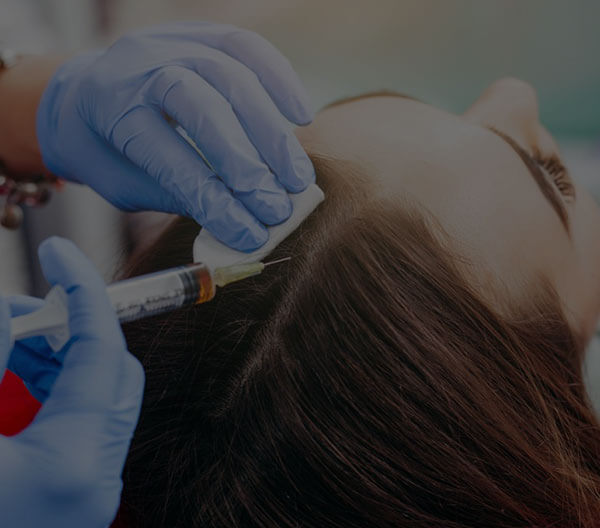PRP (Platelet Rich Plasma) for Hair Loss is now the latest trend in hair regrowth and hair loss treatment. PRP therapy for men’s and women’s hair loss is becoming more and more common and is proving to be effective in correcting hair loss when done correctly.
PRP for hair loss is a non-surgical procedure that utilizes the stem cells and growth factors from the patient’s own blood to trigger the growth of hair from resting or miniaturized hair follicles.

The centrifuge will separate the platelets from the rest of the blood. The final product is plasma that has been separated from the white and red blood cells. This plasma is then set aside and gravity allows the platelets to drop out of suspension and collect at the bottom of the tube.
This denser area of platelets in the plasma is called Platelet Rich Plasma or PRP. This area will typically have 3 -5 x concentration of platelets and is the key ingredient to success in any PRP procedure. The platelet poor plasma or PRP is usually collected from the top of the tube and discarded; or, in some cases saved for micro-needling treatment post PRP injection.
The platelet-rich plasma then is injected back into the scalp using one of two procedures:
This therapy is mostly used as a growth stimulant hair growth procedure and typically requires multiple procedures over a course of 3-6 months to begin to show results. It is important to note that PRP is not FDA approved for hair growth and there are numerous methods of delivering PRP to the scalp. It is important to review what type of procedure your physician may be practicing. You should discuss this with your physician prior to starting a course of treatment and see his or her before and after photos.
PRP for Hair Restoration and Hair Transplantation: PRP can be used in hair transplant surgery to expedite post-operative recovery. During a hair restoration procedure, some physicians will have the individual hair transplants grafts dipped in a patient's PRP prior to being placed into the patient’s scalp. This will potentially provide a greater possibility of healing and promote a better outcome
Platelet-rich plasma has approximately five times the number of platelets found in ordinary blood. These platelets have:
All the above have a positive impact on the growth of hair. Platelets stimulate the healing of wounds and cellular repair and when placed inside the scalp it seems to be able to repair areas of hair loss. Currently, there are clinical studies underway to prove its effectiveness, but those studies still will not be complete until 2019. There have been some previous studies in mice showing that PRP stimulates dermal papillae. One similar study was done on mice to assess the effect of activated PRP on hair growth. After one injection every three days for fourteen days, diffuse darkening was noticed. Mice that were injected with activated PRP showed an almost complete hair regrowth as compared to those that were not..
PRP injections are done in three steps:
PRP is not a permanent fix. Maintenance of one treatment per year is usually required to maintain results. Additionally, androgenetic alopecia is caused by the hormone, DHT (dihydrotestosterone) and PRP does not do anything to mitigate the effects of this hormone. DHT Blockers and additional hair loss products may still need to be used for an optimal long term result.
Despite some limitations, PRP injections have shown a positive therapeutic effect on both male and female hair loss without major side effects. The potential for using this therapy to boost hair loss thickness and density as a standalone treatment or after a hair transplant is good.
PRP for hair loss and the scalp is considered very safe because:
On its own, PRP is also used in hair restoration that produces great results. Using thin needles, a patient’s own PRP is injected into the scalp. The growth factors within the blood cells then go to work and trigger growth of hair. This therapy is also suitable for both men and women. The end result of this therapy is a fuller and healthier looking hair
At times, PRP may be uncomfortable and painful so topical anesthetic or cooling spray is often used. There is virtually no downtime following a procedure and you should be able to be back to work the next day with no noticeable trace of the PRP
Hair loss can occur in both men and women, and this procedure is designed with that in mind. PRP is equally effective as a way to counteract female pattern baldness as it is for our male patients. The best candidates for a PRP treatment are patients who have slight to moderate hair loss, who want to take charge and regain confidence in their look.
During your consultation, Dr. Sai Sandeepthi and his team will assess your condition in person and want to take charge and regain confidence in their look. recommend the best course of action for you. We are happy to go over any remaining questions and concerns you may have upon your visit to our Eudermiz Clinic in Hyderabad.
PRP is not a permanent fix. Maintenance of one treatment per year is usually required to maintain results. Additionally, androgenetic alopecia is caused by the hormone, DHT and PRP does not do anything to mitigate the effects of this hormone..
If you’re looking for the best Dermatologist for Melasma Treatment at Eudermiz our mobile no. Is +91-63055 35324, and our clinic phone no. is +91-63055 35324, you can also email us for an appointment. Our Email ID is - [email protected]
